General Electric Locomotives (1907-2019): A History
Last revised: August 26, 2024
By: Adam Burns
The General Electric Company has a
history that dates back to the late 1870s. Despite some bumps in the road over the years it remains one of the
largest corporations in the world, building everything from jet engines
to kitchen appliances.
GE's introduction into the locomotive manufacturing market began as early as 1918 and they built modest diesel switchers during the 1930s and 1940s.
The company also manufactured locomotives in conjunction with the American Locomotive Company (Alco) for many years.
However, this partnership cratered in the mid-1950s when GE recognized Alco was increasingly lagging behind industry leader Electro-Motive.
Over time, General Electric's locomotives became evermore reliable to the point that the company eclipsed EMD in the 1980's.
In November, 2017 GE reported its intentions to sell its locomotive division, GE Transportation.
This was made official in a press release made public at 7 AM on May 21, 2018 when it was announced that the Wabtec Corporation and GE Transportation would merge.
The marriage took place on February 25, 2019. The company is now known as Wabtec Freight.
Photos
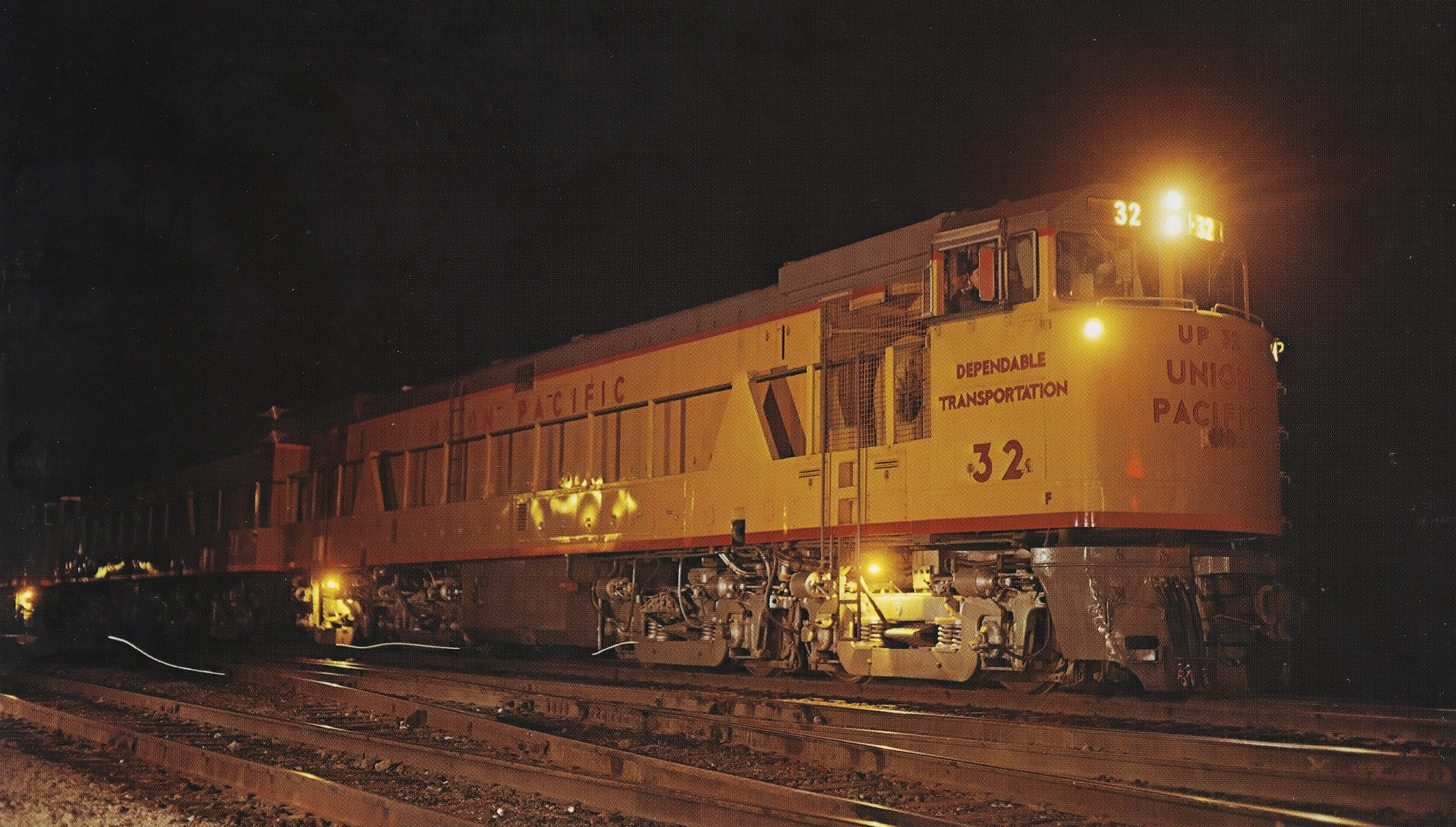 One of Union Pacific's big U50s, #32, was photographed here by Don Sims at Yermo, California on a September night in 1964. American-Rails.com collection.
One of Union Pacific's big U50s, #32, was photographed here by Don Sims at Yermo, California on a September night in 1964. American-Rails.com collection.History
GE is credited with commercially producing the very first diesel-electric locomotive in 1918, a boxcab design built for the Jay Street Connecting Railroad, #4.
Designated as model GM-50 it was essentially a diesel powered motor car, somewhat similar to an interurban car, and built in conjunction with Alco and Ingersoll-Rand.
At A Glance
* General Electric's first locomotive somewhat depends on the specific question. Thomas Edison, GE's founder, began experimenting with electric propulsion as early as 1880 and soon after did more extensive tests, in collaboration with Northern Pacific's Henry Villiard, utilizing a 2 ¼-mile test track in Menlo Park, New Jersey.
The company also did extensive testing on electric railway propulsion in the 1890s with Frank J. Sprague, Leo Daft, and Stephen Field. Sprague is recognized for his efforts in developing the first large scale rapid transit system in the nation to be powered by electric motorcars, the Richmond Union Passenger Railway (Virginia) which opened in 1888.
GE also helped develop the first main line, heavy-haul freight/passenger electric locomotive for the Baltimore & Ohio as part of its Baltimore Belt Railroad which opened in 1895. The company would go on to have a hand in virtually every other notable electric design put into service in the United States through the 1950s.
** This was followed by the Type 404-E70-4 LWP (20-500 Volt) steeple-cab electric completed in 1894 for the Cayadutta Railway of Taftville, Connecticut.
*** This locomotive was developed by none other than Rudolf Diesel himself. GE provided the generator and electrical components.
***** This locomotive utilized a GM50, V-8 engine and could produce 225 horsepower. The boxcab design weighed about 7 tons.
***** This figure is approximate. GE Transportation is still producing locomotives today and also has collaborated with other companies (notably American Locomotive) on the production of diesels since the World War I period.
Later, in 1924 the three companies built a 300 horsepower, 60-ton boxcab design. This variant was purchased by the Central Railroad of New Jersey, and later the Baltimore & Ohio.
In the following years, General Electric remained an insignificant player in the diesel-electric market, even as Electro-Motive exploded in the late 1930's.
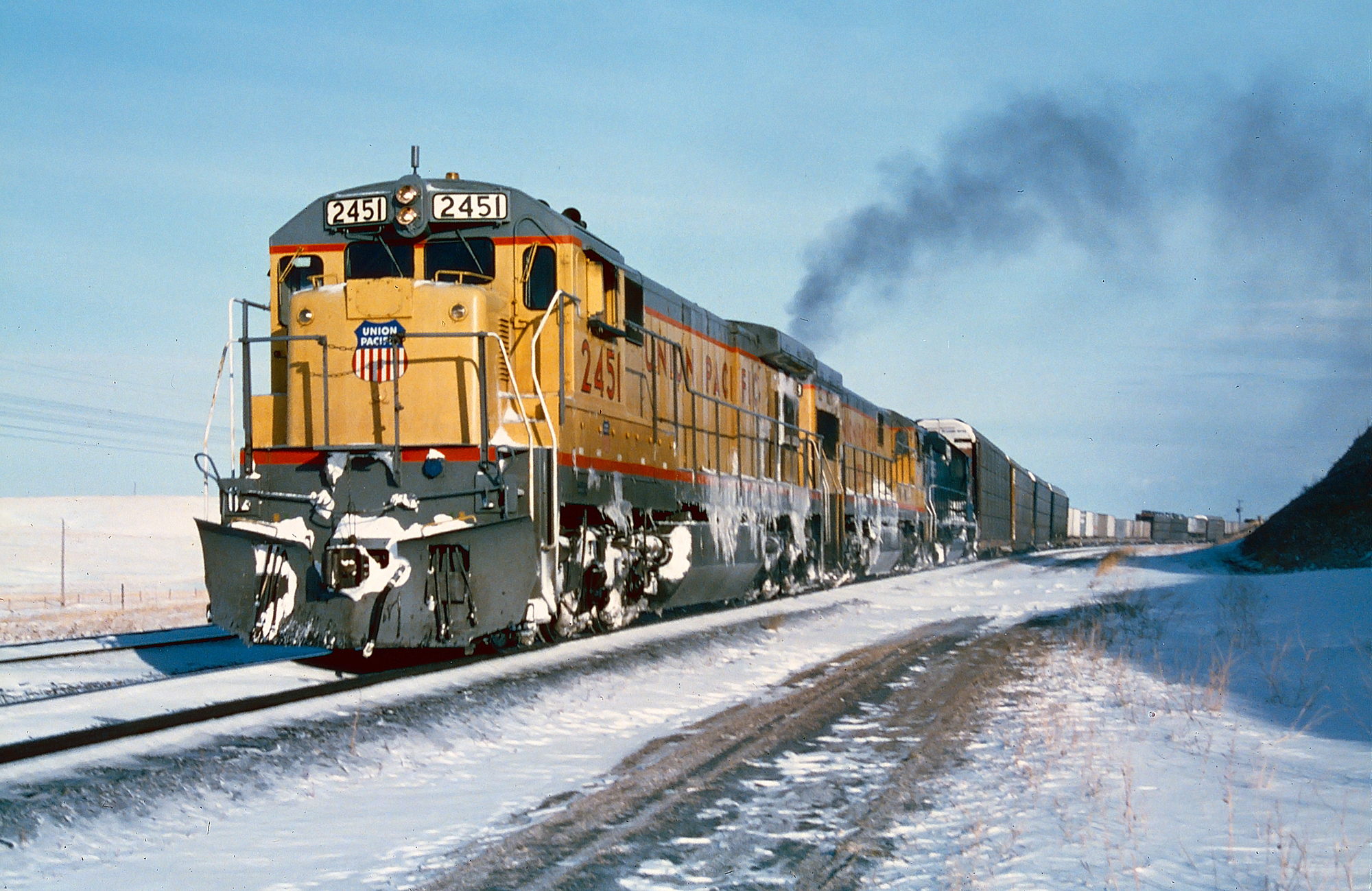 A pair of Union Pacific C30-7's, with #2451 up front, along with a former Missouri Pacific unit, lead a freight west of Cheyenne, Wyoming circa 1984. Mike Bledsoe photo. American-Rails.com collection.
A pair of Union Pacific C30-7's, with #2451 up front, along with a former Missouri Pacific unit, lead a freight west of Cheyenne, Wyoming circa 1984. Mike Bledsoe photo. American-Rails.com collection.During this time, GE's models remained small in nature, designed primarily for light branch, yard, and industrial duty. From 1928 through 1930, GE built box and some center-cab designs ranging from 300-600 horsepower.
By 1940 the company would introduce its most successful switcher to date, the ubiquitous 380-horsepower, 44-tonner.
This little switcher was beloved by industries for its lightweight design and ability to navigate tight curves. When production ended in 1956, GE had manufactured 373 44-tonners.
Universal Series
After the end of World War II, GE followed up its successful 44-tonner with heavier models like the 70, 95, and even 125 tonners.
In 1954, GE ended its partnership with Alco and for the rest that decade the company experimented with different road unit designs.
It sold a few examples of its first commercial variant, the UD18, in 1956. This led to the release of its first main line road-switcher in 1959, the U25B.
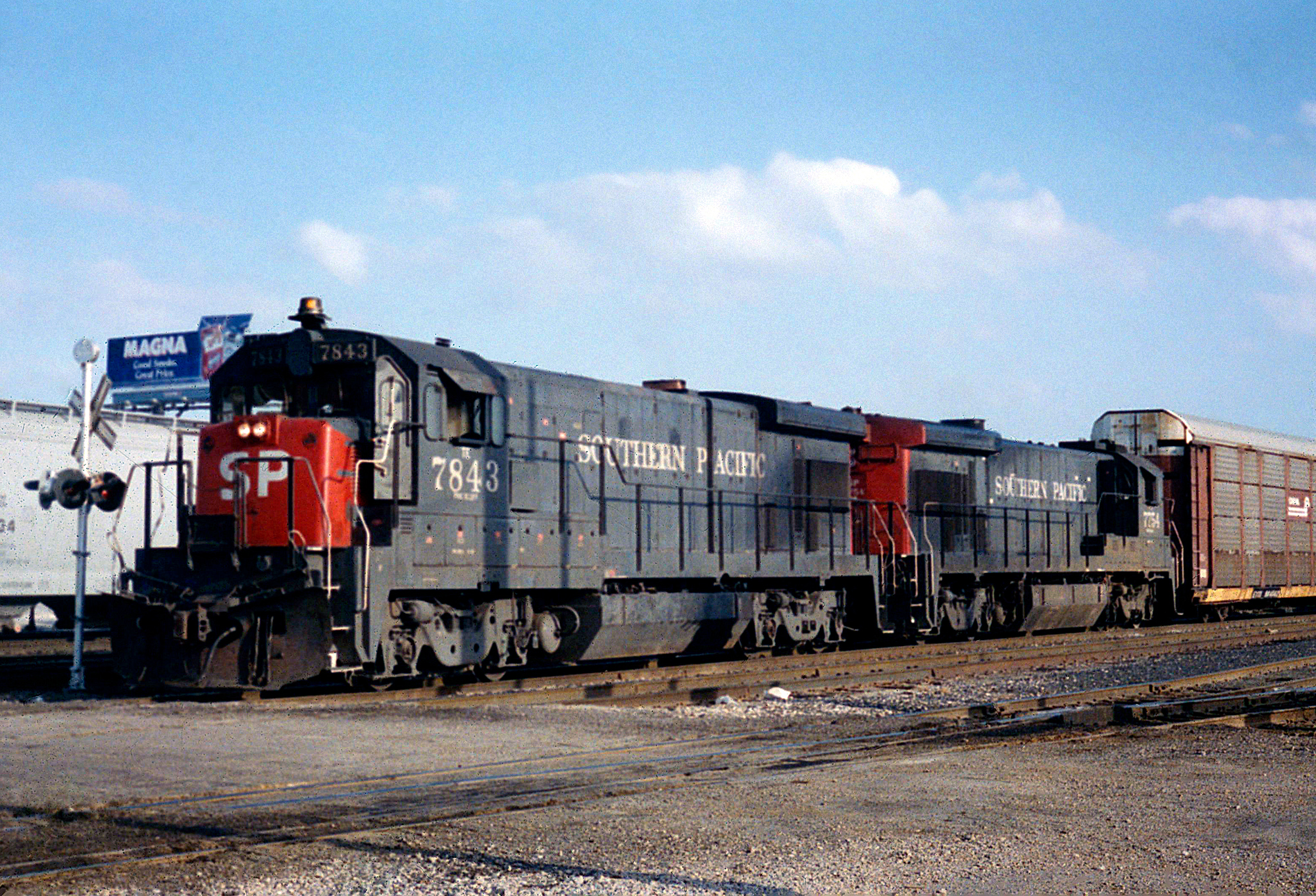 Southern Pacific B30-7 #7843 and B36-7 #7754 are stopped at a grade crossing with a string of autoracks in January, 1990. Location not listed. American-Rails.com collection.
Southern Pacific B30-7 #7843 and B36-7 #7754 are stopped at a grade crossing with a string of autoracks in January, 1990. Location not listed. American-Rails.com collection.The model was later dubbed the "U-boat" by railfans. Its designation was broken down as follows:
- "U" stood for the Universal series
- "25" for the unit’s overall horsepower (2,500)
- "B" for the number of overall axles (4)
There was nothing fancy about the U25B, especially its carbody, which carried straight lines and a short, stubby square nose.
However, the unit was durable and easy to maintain, which the railroads loved, especially the maintenance crews.
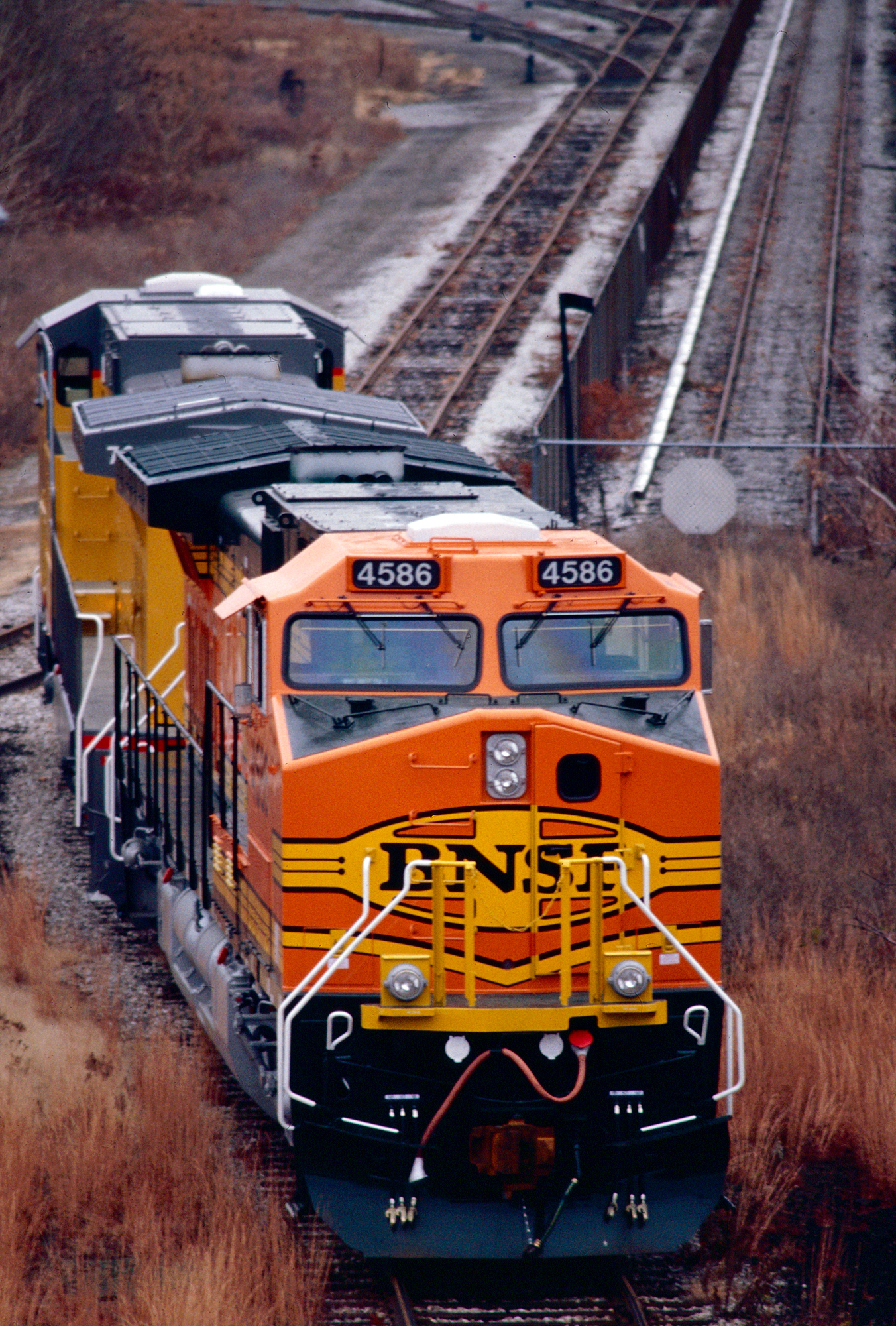 Recently completed Burlington Northern Santa Fe C44-9W #4586 and Union Pacific AC4400CW #7279 were photographed here at GE's Erie, Pennsylvania production facility in December of 1999. American-Rails.com collection.
Recently completed Burlington Northern Santa Fe C44-9W #4586 and Union Pacific AC4400CW #7279 were photographed here at GE's Erie, Pennsylvania production facility in December of 1999. American-Rails.com collection.General Electric's Universal series would ultimately span a total of six different designs in comparable B-B and C-C setups.
Ranging between 2,500 and 3,500 horsepower, all models only saw a few hundred bulit.
However, beginning with its "Dash 7" series in the late 1970s, and following with the "Dash 8" and "Dash 9" series, GE propelled itself past Electro-Motive in the locomotive market.
In the 1990s, and into the 2000s, GE further solidified itself as the leading locomotive builder by producing the successful AC series (AC4400CW and AC6000CW) that sold thousands of units.
Locomotive Models
Switchers
| Model Type | Units Built | Date Built | Horsepower |
|---|---|---|---|
| 25-Tonner | 550 | 1938-1974 | 150 |
| 35-Tonner | 120 | 1949-1974 | 150 |
| 40/50-Ton End-Cab | - | 1939-1975 | 300 |
| 44-Tonner | 386 | 1940-1956 | 300-350 |
| 45/50-Ton Center-Cab | 820 | 1939-1975 | 300 |
| 45-Ton Drop-Cab (Military) | 94 | 1941 | 300 |
| 65-Ton Center-Cab | 399 | 1940-1948 | 400 |
| 70-Ton Center-Cab | 11 | 1940-1942 | 400-600 |
| 80-Ton Center-Cab | 620 | 1936-1980 | 940 |
Other GE switcher models produced include the 65-ton, 70-ton, 95-ton, 100-ton, 110-ton, 125-ton, and 144-ton end-cab designs. The builder also cataloged a "Universal" line of switchers, most of which sold to foreign operations. These included the U4-B, U6-B, and U7-B.
Road-Switchers
| Model Type | Units Built | Date Built | Horsepower |
|---|---|---|---|
| U18B | 163 | 3/1973-10/1976 | 1,800 |
| U23B | 481 | 8/1968-6/1977 | 2,250 |
| U25B | 478 | 4/1959-2/1966 | 2,500 |
| U28B | 148 | 1/1966-12/1966 | 2,800 |
| U30B | 295 | 5/1966-3/1975 | 3,000 |
| U33B | 137 | 9/1967-8/1970 | 3,300 |
| U36B | 125 | 5/1970-12/1974 | 3,600 |
| U23C | 223 | 3/1968-9/1970 | 2,250-2,300 |
| U25C | 113 | 9/1963-12/1965 | 2,500 |
| U28C | 71 | 12/1965-12/1966 | 2,800 |
| U28CG | 10 | 7/1966-8/1966 | 2,800 |
| U30C | 600 | 11/1966-9/1976 | 3,000 |
| U30CG | 6 | 11/1967-12/1967 | 3,000 |
| U33C | 375 | 1/1968-1/1975 | 3,300 |
| U34CH | 33 | 11/1970-1/1973, 10/1978 | 3,430 |
| U36C | 218 | 10/1971-4/1975 | 3,600 |
| U36CG | 20 | 4/1974-5/1974 | 3,600 |
| U50C | 40 | 9/1969-11/1971 | 5,000 |
| U50 | 26 | 9/1963-8/1965 | 5,000 |
| B23-7 | 535 | 1977-1984 | 2,250-2,300 |
| BQ23-7 | 10 (Built For SCL) | 1978-1979 | 2,250-2,300 |
| B30-7 | 399 | 1977-1983 | 3,000 |
| B36-7 | 230 | 1980-1985 | 3,600 |
| C30-7 | 1,128 | 1976-1986 | 3,000 |
| C36-7 | 607 | 1978-1989 | 3,600 |
| Super-7N/R Series | 127 | 1989-1993 | 2,250-3,000 |
| B32-8 | 69 | 1984-1991 | 3,150 |
| B32-8W | 1 (Demonstrator) | 1989 | 3,150 |
| B36-8 | 1 (Demonstrator) | 1982 | 3,600 |
| B39-8 | 146 | 1984-1988 | 3,900 |
| B40-8 | 155 | 1988-1989 | 4,000 |
| B40-8W | 84 | 1988-1992 | 4,000 |
| C32-8 | 10 | 1984 | 3,200 |
| C39-8 | 161 | 1986-1987 | 3,900 |
| C40-8 | 584 | 1987-1991 | 4,000 |
| C40-8W | 847 | 1989-1994 | 4,000 |
| C41-8W | 108 | 1993 | 4,135 |
| C40-8M | 84 | 1990-1994 | 4,000 |
| C44-8W | 53 (Built for CSX) | 1993-1994 | 4,400 |
| C40-9 | 125 (Built for NS) | 1995 | 4,000 |
| C40-9W (Built for NS) | 1,090 | 1996-2004 | 4,000 |
| C44-9W | 2,366 | 1993-2006 | 4,390 |
| C44-9WL | 27 | 1994-1995 | 4,400 |
| C44-9WM (Built for Brazilian Railroads) | 148 | 1997-2008 | 4,400 |
| BB40-9WM (Built for Brazilian Railroads) | 251 | 1997-2012 | 4,000 |
| C44-MEi (Built for Brazilian Railroads) | 18 | 2008 | 4,000 |
| AC4400CW | 2,972 | 1993-2007 | 4,400 |
| AC6000CW | 318 | 1995-2000 | 4,400-6,000 |
| ES40DC | 220 | 2004-2008 | 4,000 |
| ES44DC | 1,149 | 2005-2010 | 4,400 |
| ES44AC | 3,764 | 2002-2020 | 4,400 |
| ES44C4 | 1,137 | 2009-2015 | 4,400 |
| ET44AC | 787 | 2014-2020 | 4,400 |
| ET44C4 | 325 | 2015-2020 | 4,400 |
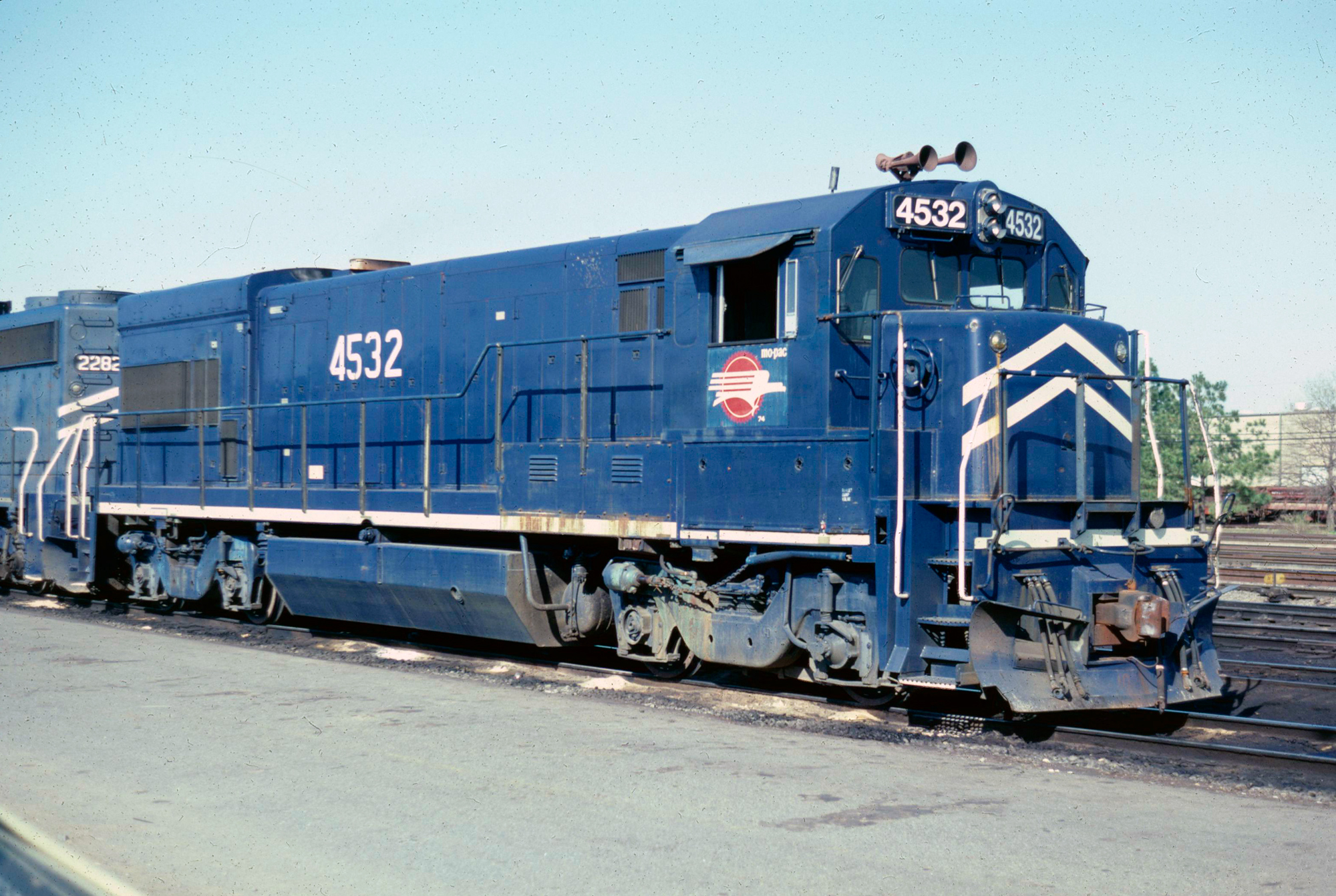 Missouri Pacific U23B #4532 was photographed here in North Little Rock, Arkansas on March 18, 1985. Author's collection.
Missouri Pacific U23B #4532 was photographed here in North Little Rock, Arkansas on March 18, 1985. Author's collection.Evolution Series
The ES40DC, ES44DC, and ES44AC are part of the newest General Electric locomotives known as Evolution Series.
Not included in the above tables are the variants and foreign examples of these designs such as the ES40ACi, ES44AC-H, ES44C4, ES44DCi, and ES58ACi.
The Evolution Series followed the builder’s Dash 9 models and is designed to offer just as much horsepower as conventional diesels but by burning much less fuel and in turn producing fewer emissions.
The series was designed to meet the EPA’s Tier 2 requirement of emissions standards and is powered by a GEVO 12-cylinder prime mover. So far these new series continues to sell well for GE, sustaining it as the premier locomotive builder nationwide.
With the marriage of GE Transportation and Wabtec, made official on February 25, 2019, the new corporation was referred to as Wabtec Freight.
Their production includes locomotives and parts, mining equipment, heavy-duty diesel engines, railroad components, information services, and transit systems.
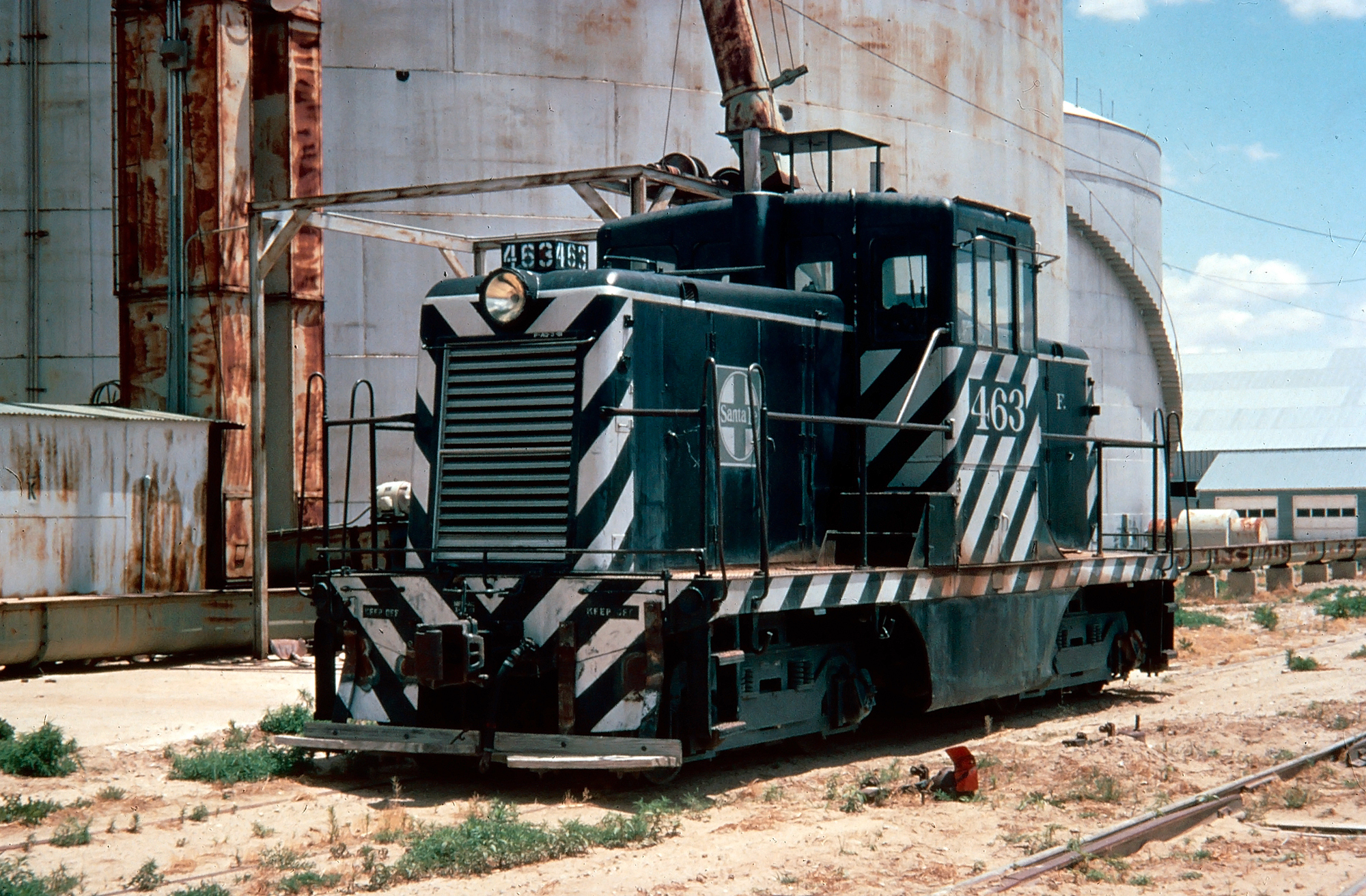 A handsome little Santa Fe 44-tonner, #463, at rest between assignments switching the American Grain Company in Plainview, Texas, circa 1970. American-Rails.com collection.
A handsome little Santa Fe 44-tonner, #463, at rest between assignments switching the American Grain Company in Plainview, Texas, circa 1970. American-Rails.com collection.Sources
- Hayden, Bob. Diesel Locomotives: Cyclopedia, Volume 2 (Model Railroader). Milwaukee: Kalmbach Publishing Company, 1980.
- Marre, Louis A. and Pinkepank, Jerry A. Contemporary Diesel Spotter's Guide, The: A Comprehensive Reference Manual To Locomotives Since 1972. Milwaukee: Kalmbach Publishing Company, 1989.
- McDonnell, Greg. U-boats. Toronto: Stoddart Publishing, 1994.
- Pinkepank, Jerry A. Diesel Spotter's Guide. Milwaukee: Kalmbach Publishing Company, 1967.
- Reed, Jay. Critters, Dinkys & Centercabs. Whittier: Rio Hondo, 2000.
- Hayden, Bob. Diesel Locomotives: Cyclopedia, Volume 2 (Model Railroader). Milwaukee: Kalmbach Publishing Company, 1980.
- Solomon, Brian. American Diesel Locomotive, The. Osceola: MBI Publishing, 2000.
- Solomon, Brian. GE Locomotives: 110 Years Of General Electric Motive Power. St. Paul: MBI Publishing, 2003.
Contents
Recent Articles
-
The Wrecking Derrick: Railroading's Unsung Hero
Nov 19, 24 02:08 PM
The wrecking derrick was once a vital piece of maintenance-of-way equipment, ensuring rail lines were quickly reopened following an accident or derailment. -
Buckingham Branch Railroad: Serving Central Virginia
Oct 28, 24 05:17 PM
The Buckingham Branch Railroad is a 275 mile short line that has served Virginia since 1989. -
New York & Long Branch Railroad: An NJ Commuter Line
Oct 26, 24 11:50 PM
The New York & Long Branch Railroad was an historic system running along the northeastern coast of New Jersey and jointly owned by the CNJ and PRR. Today, it is operated by NJ Transit.


